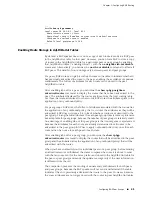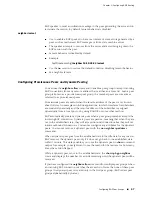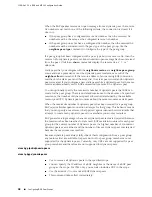
■
This command takes effect immediately and automatically bounces the BGP
session.
■
Use the
no
version to return BGP to halt acceptance of such routers. Use the
default
version to remove the explicit configuration from the peer or peer group
and reestablish inheritance of the feature configuration.
■
See neighbor ebgp-multihop
Specifying a Single-Hop Connection for IBGP Peers
IBGP peers are multihop by default. However, you can use the
neighbor
ibgp-single-hop
command to enable single-hop connections for IBGP peers.
neighbor ibgp-singlehop
■
Use to specify an internal BGP peer as a single-hop peer for IBGP sessions.
■
If you specify a BGP peer group by using the
peerGroupName
argument, all the
members of the peer group inherit the characteristic configured with this
command unless it is overridden for a specific peer.
■
If the neighbor session type is anything other than internal BGP, issuing this
command generates an error message.
■
This command takes effect immediately and automatically bounces the BGP
session.
■
Example
host1(config-router)#
neighbor 192.168.32.15 ibgp-singlehop
■
Use the
no
version to restore the default behavior, wherein the internal peer
cannot be a single-hop peer. Use the
default
version to remove the explicit
configuration from the peer or peer group and reestablish inheritance of the
feature configuration.
■
See neighbor ibgp-singlehop
Controlling the Number of Prefixes
As the routing table increases in size, the processor and memory resources required
to process routing information increases. Some peers send so much routing
information that a BGP speaker can be overwhelmed by the updates. You can use
the
neighbor maximum-prefix
command to limit how many prefixes can be received
from a neighbor.
The router resets the BGP connection when the specified maximum is exceeded.
You can use the
warning-only
keyword to log a warning rather than reset the
connection. You can also configure the router so that a warning is logged when a
specified percentage of the maximum is exceeded.
In the following example, the router is configured to reset the BGP connection when
it receives more than 1,000 prefixes from its neighbor at 2.2.2.2:
Configuring BGP Peer Groups
■
33
Chapter 1: Configuring BGP Routing
Summary of Contents for BGP
Page 6: ...vi ...
Page 8: ...viii JUNOSe 11 1 x BGP and MPLS Configuration Guide ...
Page 37: ...Part 1 Border Gateway Protocol Configuring BGP Routing on page 3 Border Gateway Protocol 1 ...
Page 38: ...2 Border Gateway Protocol JUNOSe 11 1 x BGP and MPLS Configuration Guide ...
Page 234: ...198 Monitoring BGP JUNOSe 11 1 x BGP and MPLS Configuration Guide ...
Page 236: ...200 Multiprotocol Layer Switching JUNOSe 11 1 x BGP and MPLS Configuration Guide ...
Page 542: ...506 Monitoring BGP MPLS VPNs JUNOSe 11 1 x BGP and MPLS Configuration Guide ...
Page 544: ...508 Layer 2 Services Over MPLS JUNOSe 11 1 x BGP and MPLS Configuration Guide ...
Page 610: ...574 Virtual Private LAN Service JUNOSe 11 1 x BGP and MPLS Configuration Guide ...
Page 624: ...588 VPLS References JUNOSe 11 1 x BGP and MPLS Configuration Guide ...
Page 680: ...644 Virtual Private Wire Service JUNOSe 11 1 x BGP and MPLS Configuration Guide ...
Page 724: ...688 Monitoring MPLS Forwarding Table for VPWS JUNOSe 11 1 x BGP and MPLS Configuration Guide ...
Page 725: ...Part 6 Index Index on page 691 Index 689 ...
Page 726: ...690 Index JUNOSe 11 1 x BGP and MPLS Configuration Guide ...
















































